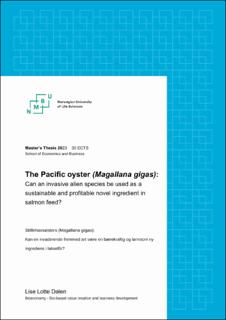| dc.description.abstract | The uncertainties regarding sustainability of feed ingredients used for the farming of Atlantic salmon (Salmo salar) are receiving increasing attention from stakeholders and policy makers. At the same time, the Pacific oyster (Magallana gigas) has invaded the Norwegian coast,
potentially threatening local biodiversity and the continuation of ecosystem services. The aim of this thesis was to provide a broad basis for assessing the opportunities and challenges of
using the Pacific oyster as an ingredient in salmon feed. This was done to potentially mitigate the negative impacts of other commonly used feed ingredients such as fish meal and soy protein concentrate, while at the same time contributing to the management of an invasive alien species.
To achieve this, the thesis includes a systematic literature review about the implications on sustainability from the invasion of the Pacific oyster and from common salmon feed ingredients. Semi-structured interviews were conducted with a representative from each of the four main salmon feed production companies in Norway, in addition to Petter Bjørge from the oyster harvesting company Storm Østers AS. It contains an analysis of the nutrient comparison of the dried Pacific oyster meal, soy protein concentrate and fish meal. The digestibility of the dried oyster meal was evaluated in a feeding trial using mink (Neovison vison) as a model animal for salmon, and compared with digestibility coefficients of soy protein concentrate and fish meal. On a dry matter basis, the Pacific oyster consisted of 49.3% crude protein, 20.4% ash, 8.2% fat and 0.71% EPA+DHA. When compared to requirement estimates of essential amino acids for salmon, the first limiting essential amino acids were phenylalanine and tyrosine, followed by methionine+cysteine, histidine and lysine. The apparent digestibility coefficient of crude protein was 79.5%. The nutrient profile was considered interesting but not optimal by the feed producers interviewed. The price per tonne dried oyster meal is 825,688 NOK, a price that, at present, does not allow the Pacific oyster to compete on the market with other common salmon feed ingredients. The harvesting capacity of Storm Østers AS was estimated to allow for the annual production of 26.5 tonnes of dried oyster meal, which is an insufficient volume to satisfy the smallest annual requirement of salmon feed producers. Compared to the sustainability profile of soy protein concentrate and fish meal, the Pacific oyster harvesting comes with a
favourable sustainability profile that allows for the continuation of ecosystem services in the harvested areas, with some uncertainties related to energy use while harvesting and processing. During the preparation of this thesis, it was discovered that feed producers are not looking to reduce their reliance on common feed ingredients, particularly marine ingredients, limiting the potential of novel feed ingredients to have a mitigating effect on the current use of unsustainable ingredients. | |
